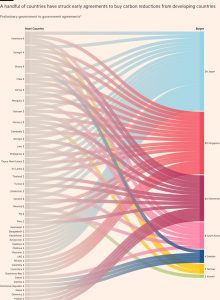Four investment mistakes you really don’t want to repeat
Some people collect classic cars. Others collect Chinese porcelain. I collect mistakes. My own and those of others.
It can be uncomfortable seeing how fallible we are. But errors help show us how our brains work. My aim in writing this new column is to investigate financial thinking, good and bad, particularly in relation to investment.
If we understand our minds better, we should be able to avoid mistakes more easily, especially the kind that cost us money.
Sometimes, people blunder on a heroic scale. In the 19th century, Germany swapped a claim on Zanzibar, a lucrative trading centre, for the Caprivi Strip, a remote corridor of land in the middle of Africa controlled by Britain. This connected German colonialists on the south west of the continent with the mighty Zambezi River. That was meant to give them a valuable trading route to the east coast.
Germany appears to have overlooked or underestimated the Victoria Falls, 40 miles downriver. You would not want to go over this 350-foot cascade in a steamship.
The statesman after whom the Strip is named, Graf von Caprivi, is now mainly remembered as a lousy deal maker with an amazing moustache. He allowed his enthusiasm to run ahead of his knowledge.
The late Daniel Kahneman, a doyen of decision making, might have classified Caprivi’s cockup under his snappy heading “What you see is all there is”.
This slip-up occurs when we assume a situation is defined fully by the limited information we possess. Investors are prone to this when, for example, we imagine that the quantified part of an emerging corporate disaster is the whole thing.
This happens repeatedly. In 2011, Lloyds said insurance mis-selling would cost it £3.2bn. The bank’s eventual bill was more than £20bn. Initial cost estimates were also too low when alleged money laundering was uncovered at Danske Bank and medical devices made by Philips malfunctioned.
The Lex column, which I edited for several years, like fellow FT Money columnist Stuart Kirk, correctly identified the shortfall at the Danish lender and the Dutch medical technology company. In an earlier assignment as a City commentator, I had loftily suggested that Lloyds padded its initial liability estimate, so it could release provisions later.
I was reminded of that mistake every time the bank stuck another billion on projected mis-selling expenses. I have made plenty of errors as a private investor too. Here are four blunders I hope never to repeat.
Planning to recoup the in-price on a bad investment
In the early 2010s, I used a workplace savings scheme to buy shares in Pearson, which owned the FT until 2015. Believing quite wrongly that education was universally desired and Pearson uniquely equipped to provide it, I went in at just over £12 per share. I sold at around £10.50 a few months ago.
I had been loath to sell below my in-price because it would have meant crystallising a loss and admitting I was a loser, albeit in the narrow discipline of investing in education multinationals. It would have been better to think about my investments in the round, without ego and to have sold out earlier.
Thinking in nominal prices
It was just possible to kid myself that a £1.50 per share loss is not so bad when a stream of dividends compensates you for it. But in real, inflation-adjusted terms, I was still 14 per cent down, payouts included.
The only point of investing is so you or someone else can spend the money on goods or services in the future. So you need to adjust return figures for the dwindling purchasing power of money. You should also measure how your portfolio performs relative to lower risk benchmarks.
Buying high and selling low
Nobody does this on purpose. But private investors mostly dip in and out of the activity. We tend to arrive late to the market’s fiestas and wakes. A successful business or sector has an alluring halo. Doom and cobwebs cling to the business or industry that is doing badly. Financial commentators are partly responsible.
When I confessed this to an ex-fund manager, he said: “Don’t worry, journalists are natural trend followers.” That made me feel better — until I realised that “trend follower” also describes wool-bearing animals that run around in herds and lack basic survival instincts.
One solution is to avoid “timing the market,” as attempts to buy low and sell high are termed. But this is a lot harder than it sounds. Most of us invest money in lumps and take it out again in the same way. You are then timing the market, even though you did not intend to.
Compulsive storytelling
Humans have an insatiable hunger for narratives. Stories help us to come to terms with a world where chaos often reigns. But it is easy to start building a narrative out over a chasm.
Demonstrating the panache of the young and deluded, I once wrote that the go-go Japanese stock market could not crash. The Ministry of Finance simply would not allow it, I explained. Tokyo stocks duly halved in 1990, heralding three decades of stagnation.
It is true that some Asian countries have cultures more consensual than western ones. It is not true that this permits their governments to dictate share prices.
I am innocent of one key piece of wonky thinking: imagining I will be the first person to write about its financial aspects. Kahneman’s brilliant 2012 compendium of cognitive biases, Thinking, Fast and Slow, boasts numerous financial case studies. US personal finance guru Jason Zweig has written extensively on the subject. Writers as far back as Joseph de la Vega in 1688 have anatomised the delusions that grip investors.
The basic question is: “how can we learn from our mistakes?” That has defined humanity ever since an early human bashed its thumb while making the first stone tool. In these FT Money columns I hope, with help from experts, to supply a few fresh answers.
Jonathan Guthrie is a journalist, adviser and a former head of the Lex column. Email: [email protected]
#investment #mistakes #dont #repeat




